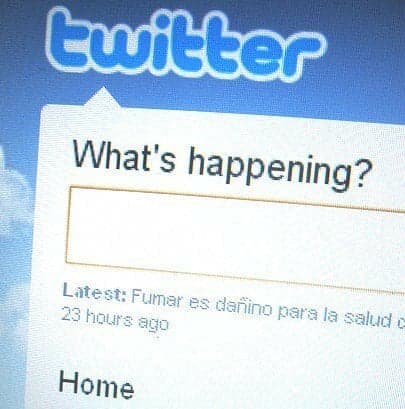Your Facebook profile boasts scores of friends. Your wall is rife with status updates ranging from your weekend plans to your latest song selection from Spotify. You’re up-to-date with the latest in network changes, your privacy settings are pristine, and you “like” among the best of ‘em.
But Twitter? You just don’t get it.
You’re not alone. Five years since its inception, Twitter is as popular as ever, but still remains a mystery to many. But—kick and scream all you want—there might come a situation in which you’re forced to hop on board: your new co-workers (and your CEO) tweet all day, you’re trying to up your networking game, or your pals have finally worn you down, to name a few.
So how do you join in the 140-character conversation at this stage in the game? Have no fear—it’s actually a lot simpler than you might think! Here’s a crash course in the basics to get you started in the Twitterverse.
@ Symbol
If you want to get someone’s attention on Twitter, @ is where it’s at! Not just for email addresses, @ always precedes a user’s name (i.e. @dailymuse) and is the universal Twitter symbol for public (read: everyone can see it) conversation. Eager to respond to an interesting question? Plug in @, followed by a user name and your comment, and the recipient will be notified immediately via their @Mentions tab.
One of the great advantages of Twitter is that it is an open forum where you have the ability to reach out to anyone publicly, even if they’re not following you back. Dying to give @MicheleBachmann a piece of your mind, or perhaps profess your love to @RyanGosling? The @ symbol makes it all possible.
Direct Message (DM)
If you prefer to contact someone privately, a direct message (DM for short) is your answer. You can craft a DM on Twitter via the “Messages” tab, or by simply inserting the letters DM into your Tweet, sans @ symbol. For example:
“DM dailymuse Want to meet over coffee sometime to discuss great content for women?”
Unfortunately, unlike public tweets, you can only DM someone if they’re already following you.
Retweet (RT)
Like what someone has to say on Twitter, or find an inspirational quote you’d like to pass along? Use the retweet (RT) feature, which allows you to share comments, links, and quotes with your followers. You can publish a retweet either by clicking the “retweet” button, or by cut-and-pasting the post you’d like to share into a new tweet and prefacing it with the letters RT. For example:
RT @FemaleEquality The great use of life is to spend it for something that will outlast it. -William James
# Hashtags
Certainly one of the more perplexing aspects of Twitter, hashtags (# for short) represent popular topics or keywords that users are currently tweeting about. Hashtags range from the serious (#OWS forOccupy Wall Street) to the absurd (#WhyIsntThisaBandName) and are searchable, making them an ideal way for you to jump into a conversation you care about. Just add your hashtags of choice to the end of your Tweet (or don’t—they’re totally optional).
Shortening Links
Got something you want to share with your followers, but bound by Twitter’s 140-character limit? Say hello to URL shorteners, which reduce the length of links to just a few short letters and numbers so you can squeeze them in your Tweet. A few popular link shortening services are bit.ly, TinyURL, and is.gd.
Recently, Twitter added its own URL shortening feature that automatically shrinks any link you enter into a Tweet to just 19 characters, freeing up plenty of valuable space.
Following Fundamentals
Highly valued in the Twitter community, a “follow” means that someone is subscribing to your Tweets. Twitterers often decide to follow a user when they enjoy what he or she has to say, frequently hoping that you might return the favor and follow them back.
Though many obsess over the number of followers they have, critics argue that it is quality, not quantity, that truly matters. Quality followers are the ones who are genuinely interested in what you have to offer, and who will engage with you, reply to your tweets, and retweet your content. Steer clear of aggressive followers and spammers who mass-follow hundreds of accounts at once in order to garner attention.
Twitter Lists
Seeking a better way to keep track of all of those folks you’re following? Twitter Lists, which organize others into groups based on credentials you specify, are here to help. When you create a list (i.e. “Great Career Experts”) and click on it, only updates from the people on that list will appear in your timeline stream. It’s not necessary to follow another user to add them to a list, and lists can be either private or public (so other users can follow it, too.) Lists are a great means of keeping tabs on Twitterers who really matter to you and sharing those people with others who might also appreciate what they have to say.
Twitter Chats
If you’re eager to discuss a certain topic online with like-minded strangers, Twitter Chats are the perfect solution. Searchable via a given #hashtag and held at a specified time, there’s a Twitter Chat for everyone (i.e. #careerchat, #GenYChat, and #bakechat; see a complete list here). They’re a great way to network with others, and most importantly, they’re lots of fun!
For more information on Twitter Chats, check out our helpful tutorial.
Take a deep breath: that wasn’t so bad, was it? Now that you’ve got the hang of it, get out there and Tweet (and see what else Twitter’s useful for—besides sharing what you had for lunch). #ipromise #youcandoit

